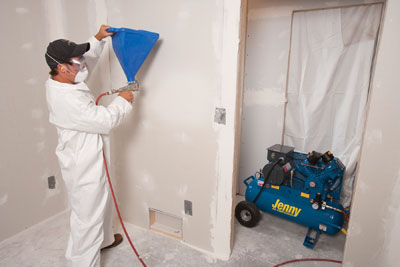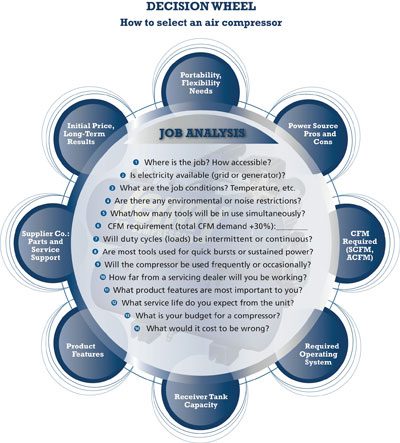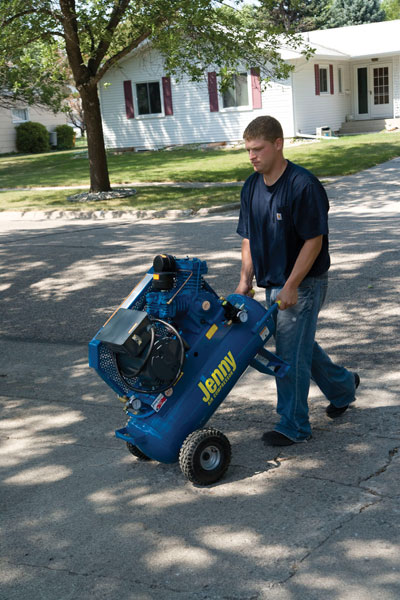
Air Time
By Daniel Leiss president Jenny Products
ProductsDeciding on the type of compressor that will best suit your customers’ needs often turns out to be more complicated than you first imagine. Once you start looking into it, you find all sorts of factors to consider.
Deciding on the type of compressor that will best suit your customers’ needs often turns out to be more complicated than you first imagine. Once you start looking into it, you find all sorts of factors to consider.
 |
|
| Potential compressor uses are so diverse, it pays to give your rental staff a good, fundamental understanding of how to apply a compressor to a particular job.
|
It may often seem you cannot choose a model without first deciding on a certain feature, which depends on your decision on another feature, which, sure enough, goes back to the first choice you had to make and could not have made without knowing all the rest. It’s a cat’s cradle.
For instance, say a customer comes in to rent a compressor. How much air do they need? Well, that depends. Will they be using a nail gun that uses quick bursts of air, or a grinder that runs continuously?
Those questions direct you to look first at the volume of the receiver tank. But, they mention they’ll need enough air to run a grease gun and a one-inch impact wrench at the same time. Ah, that’s a matter of capacity – CFM.
But their owner’s manual also says the wrench requires 170 psi. In that case, they’ll need to be looking at a two-stage compressor. A single-stage compressor may deliver higher CFM but top out on pressure at 150 psi. And the customer wants to hold the weight and cost down, which points to an electric unit, but they may be working in a remote area, which demands a gasoline engine.
It can be maddening trying to pinpoint what most customers will need and request. But let’s look at the Decision Wheel (this page) and take the points around it one by one. Then things will clear up quickly. Start at any point on this Decision Wheel and move around it in any direction since all the issues eventually come up. For now, let’s start at the top.
Portability and flexibility
When looking at hand-carry or wheeled air compressors, portability will be a given. The bigger concern will be ensuring the model you think most customers will prefer also meets their pressure and capacity requirements. With their low weight and compact configuration, these air compressors can go pretty much anywhere – with one condition, which is what we need to look at next.
Power source
The next obvious step involves asking the customer where the compressor will be used. If they will be working in a remote area without access to electrical power, either from the grid or from a generator onsite, their only choice is a gasoline engine model. That will give them complete mobility; they can get it to any jobsite and move around freely once they’re there.
But there may be other issues that come into play, such as environmental restrictions – emissions in a confined space or noise abatement – that cancel out the advantage of convenience. The gasoline model also will weigh more and both the purchase price and ongoing costs will be greater, but it will provide higher actual horsepower than its electric-motor counterpart.
CFM required
Besides power, capacity will directly impact what the compressor will enable a customer to do. Begin by helping them add the CFM requirements for all the tools they plan to use simultaneously and then add another 30 per cent of that to allow for unknown or uncommon compressor usage. The CFM demand will be either on the tool itself or in the owner’s manual. Capacity or volume can be figured three ways:
- Displaced CFM (DCFM) is simply a mathematical calculation of the bore, stroke and rpm. But, it does not take into account any of the important variables, such as temperature, atmospheric pressure, humidity, friction or heat dissipation, and therefore it means almost nothing in the real world.
- Standard CFM (SCFM) is a better measure of reality. SCFM is the flow of free air in a standardized environment – such as 14.5-psi atmospheric pressure (the pressure at sea level), 68 F and zero per cent humidity. This is a standardized metric, and it’s the best figure to use in comparing air compressors across the board, apples to apples. But what about your specific location? Are you established in mile-high Banff, when in January it sure isn’t 68 degrees? Or, are you at sea level in Moncton, where in July the temperature and humidity needles are on the peg?
- Actual CFM (ACFM) is the number that calculates in the variables that apply to a specific situation. It will give the output of the pump for the actual working conditions. But ACFM is a hard figure to get, precisely because it does require site-specific data and calculations that may be best left to an engineer.
So for selection purposes, the best bet is to compare air compressors based on the SCFM ratings. Note, too, that CFM is often shown at various pressures. These numbers can be useful in determining if a compressor produces enough volume for an application, but they can be confusing when trying to compare different compressors or compressors rated at different pressures. So again, SCFM is best. It levels the playing field.
 |
|
| Selecting a compressor involves a matrix of interconnected factors. Using this wheel can make things a bit easier.
|
Required operating pressure
CFM also will be important to know when a customer is considering a single-stage compressor versus a two-stage model. Begin by asking them to list the minimum operating pressure requirements for the tools they are going to use, which will indicate whether they need a single-stage compressor or a two-stage.
Single-stage compressors are fine up to 150 psi. For anything more than that they will need a two-stage. A single-stage compressor will typically have a higher CFM rating, because the cylinder is drawing in air and compressing it with every rotation, whereas a two-stage is compressing the air up to an intermediate pressure in one cylinder and then passing it on to another cylinder to finish the job. Because the air is typically passed through an intercooler between stages, a two-stage compressor is more efficient at higher pressures.
Receiver tank
Once again, the capacity of the compressor tank, which is usually measured in gallons, depends on how a customer intends to use the compressor. If they will be running tools that require quick, concentrated bursts, such as air nailers, a small tank is best. If the tools are to be used for sustained periods, as with board sanders, grinders and impact wrenches, they’ll want a larger tank. Think about it – it’s like blowing out a candle compared to blowing out a birthday cake covered with candles. You have to fill up your lungs for the birthday cake; the candle you can do with a puff.
Product features
The key word for quality in air compressors is durability. Durability means longevity, and longevity brings about the best return on investment. Invest in quality up front and it will better endure the abuse of the industry and provide more rental income over the product’s life. The more rental returns the compressor can withstand, the more profit it will bring.
Look for long-term durability features, such as a cast-iron cylinder, a heat-dissipating aluminum head, an efficient cooling system, structural protection for critical components and fittings, a heavy-duty steel frame and powder-coat or electrostatically applied paint to resist chipping and wear. Anti-vibration feet will help keep the noise down and keep the compressor from rattling itself apart.
Check into service life – how long is the unit designed to last? Consider the unit’s size and weight, too, and how it might impact a renter’s decision. Check whether the listed weight of the unit actual is the weight or the shipping weight. It seems obvious that the key number for the user would be actual weight, but often it is the shipping weight that is shown. Look at hose diameter, too. Don’t skimp on width by using a 1/4-inch hose if a 3/8-inch hose will be needed to handle most customers’ needs. But, be realistic. Make sure the larger hose will justify its extra weight and cost.
Supplier company, parts and service support
 |
|
| Portability is often the main concern for renters. Consider this factor before anything else.
|
Asking questions of your supplier helps determine quality factors that can’t necessarily be seen. Are air compressors the primary or sole business of the supplier? Does the company make its own products, or source them from a third party? How long has the company been in the air compressor business? All we know about the future is what we know about the past, so look at the company’s history in this market. Can the supplier answer every question clearly and explain the subtleties that only an expert would know? What about the availability of technical help, parts and service, and the distribution network?
Initial price and long-term costs
When it all adds up, what will be the price over time? Consider how your clientele will likely use each compressor, how often it will be rented out and the length of time it will be out of the store. The big question in the selection decision is this: What would it cost you to be wrong?
Overall, the most critical issue to keep in mind is each customer’s needs. Every job application has its own requirements, and a customer will need to understand the needs for the specific work situation. These core topics on the Decision Wheel should lead you to a pretty good understanding of how to help a customer with the problem they’re trying to solve.
Remember, it makes little sense to buy more than what is needed, but it makes no sense at all to buy less. What you are buying ultimately is not an air compressor but rather a solution to your customers’ problems. You could urge them to try to get by with just one aspirin, but they’ll still have the headache. Analyze the decision points thoroughly while considering your customer base in order to find the best solution for the present and future of your business.
Dan Leiss is president of Jenny Products in Somerset, Penn. He can be reached at 1-814-445-3400. For more information on Jenny Products, visit www.jennyproductsinc.com .
Print this page
Leave a Reply